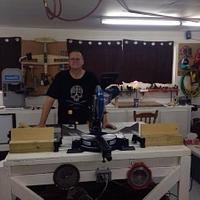Kelly
in over 11 years
Bead Bracelet Making Jig
My wife is enjoying glass bead work (e.g., bracelets, necklaces and window dressings). Every once in a while, I do a bit of digging around the net to find things that would make her hobby easier, or to allow her to increase her efficiency or abilities.
While I’ve been able to steal a lot of ideas from the Net, looking around, there seemed no solutions to some of the problems with which she was dealing:
- Little spring thingamajigs are sold that are supposed to hold the end of the string, cable or cord [string] being used, so the beads will not slip off the other end. However, they cannot always be trusted to always grip the string enough to insure you don’t have to chase beads around the floor..
- Sometimes, it is nice to have an anchor for the end of the bracelet, to increase control of the operation.
- Different people need different sizes of bracelets, so it’s nice to have a ruler handy to be able to attain the length you need. Of course, repeatability is crucial.
While out in the shop, I often distract myself with other projects, while I ponder solutions for another project. So it went yesterday, when I grabbed some scrap, a hanger bolt, a knob and and washer, then made my wife a simple bracelet jig.
As is often the case, I come up with something, then search the Net to see how others did it. There were none, other than those who make paracord bracelets, but which would not work for the purposes described.
Below is the results. Because of the simplicity of the jig, I wont offer any details, other than the following:
- The piece of plywood is about 1-1/2" wide and 12" or so long.
- The hanger bolt is about 1-1/2" long and is a 1/4×20 thread, common for many jigs.

4 Replies
What a fantastic tool for her. You have a great skill in finding a need then crafting a solution. Excellent work.
CHRIS, Charlottetown PEI Canada. Anytime you can repurpose, reuse, or recycle, everyone wins!
My wife says it works far better than the method of just using a spring. she made five bracelets for a test drive, before wandering off to work.
As a improvement, I’m doing another and adding a rounded groove to better direct the beads down a row (just because).
To make the clamp block still work, I’ll rabbit the area of the block the depth of the groove.
The sides stick up about 1/8”. Originally to cover the plywood edges, the lips stop bead-floor chaos.
The new one will not have a lip on the back. This will allow the user to push the string/cable/nylon out the back to leave enough to secure the ends.
Yesterday, I down loaded “printable rulers.” If you follow the advice and remove the command to adjust for page size, they are close enough to my machinist ruler for most simple projects.
That’s fantastic.
CHRIS, Charlottetown PEI Canada. Anytime you can repurpose, reuse, or recycle, everyone wins!
Very cool. Your a good husband. You cook too? Lol Well thought out.
Jeff Vandenberg aka "Woodsconsin"










